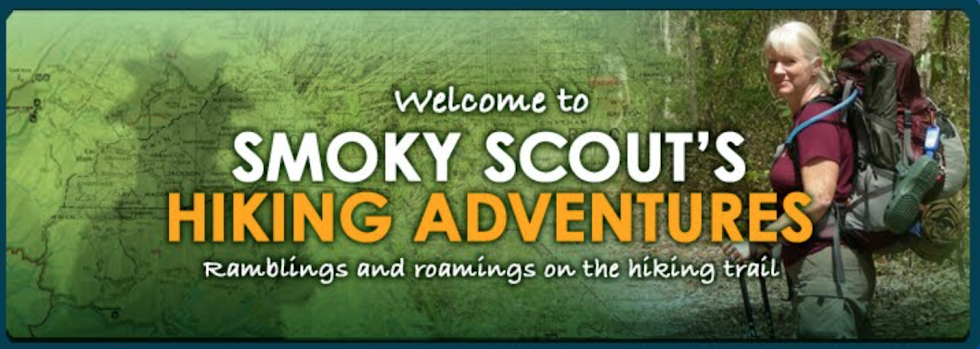Pisgah 400: Case Camp Ridge/BRP/Seniard Ridge Loop Hike – 2/9/22 – 7.5 Miles
When the Blue Ridge Parkway is closed to vehicular traffic, we bipedal thrill-seekers take advantage. Cyclists enjoy the road when it’s dry and clear and cross-country skiers rule when the white stuff accumulates. Hikers do both!
I don’t hike alone in very cold temperatures (safety in numbers when hypothermia is possible) and I missed a couple of opportunities to do this winter hike with a group. I went out on a limb and asked my friend Nancy if she’d like to meet me for a mid-week hike. She asked if she could invite another friend – and that’s how I got to meet Anita.
I left home in the dark (about 6:15 a.m.) for the unavoidable long drive to Pisgah National Forest. The mountains are where they are! We all showed up at the trailhead at 9:00 a.m., introduced ourselves, checked the current temperature (24 degrees) and took a “start photo.”
If you’re going in wintertime, check with the Pisgah Forest Ranger District to see if the gate to FR 475B is open. If they say it’s not, be prepared to add a couple of miles to your hike… or be pleasantly surprised like I was to find it open anyway.
Case Camp Ridge Trail is 1.5 miles of heart-thumping uphill, about 1,000 feet elevation gain. I suspect my friends hiked in a slightly lower gear to give me some grace and I pulled it off with only a couple of 30-second stops. Maybe I should have eaten the Clif bar that was in my pocket before I started the hike?
On my last gasp, we reached the Blue Ridge Parkway and saw that the recent snow had melted from the pavement. We enjoyed walking the “yellow blaze” for 1.5 miles southbound. There were a couple of big blowdowns that had been cleared down to one lane, presumably to allow for park employees and rescue vehicles.
The real reason for hiking on the BRP in the winter - icicles! Most of the rock walls along this stretch are east-facing, exposed to the morning sun. Maybe that helped with the freeze-thaw cycle that created these impressive ice formations that can only be glimpsed as you whiz by in a car. Yet here we were, standing as in an art gallery, admiring nature’s sculptures – until pieces began falling off – yikes!

 At Looking Glass Rock Overlook, the morning sun casts a blueish haze
At Looking Glass Rock Overlook, the morning sun casts a blueish hazeCan you see the glistening ice on the rock face?
Too busy talking, I almost missed the turn off the Parkway onto Seniard Ridge Trail. Nancy spotted it behind a guard rail (Umm, do we need to turn here?)
As steeply as Case Camp Ridge Trail lifted us up to the BRP, Seniard Ridge Trail switchbacked us back down before leveling out to a reasonable grade. Glad there was no snow or ice on the trail because my spikes were, of course, left behind at home. With plenty of breathing room, we kept up a steady conversation to match our hiking pace, comparing notes and stories of places we’ve hiked. Today was a social event, not an introspective, reverence-for-the-woods type of hike. Okay with me as I soaked up information and inspiration.
Seniard Ridge Trail crosses a couple of old forest roads, and my GAIA topo maps and NatGeo maps are dated and did not agree. Fortunately, my obsession with research turned up a hike report with screenshots to help me determine the proper route so I could keep my eyes open for a couple of waterfalls. [Is that nerdy enough for you?]
The trail settled on FR 5043 and we crossed Big Bearpen Branch, then an unnamed branch where Logging Road Falls was right by the road. This waterfall is part of the Carolina Mountain Club’s Waterfalls 100 Challenge. In summer its multiple cascades are obscured by overgrowth.

 A very sturdy bridge on the old roadbed
A very sturdy bridge on the old roadbedThis was a logging road, built to accommodate heavy equipment
We tried to find Upper Log Hollow Branch Falls, following what we thought was a faint trail from the road up the right side of the creek. In the spring we would not have considered this at all, but with no undergrowth we convinced ourselves because we knew that’s where the falls had to be. Talk about calf stretching! Whew! I thought all the uphill was out of the way. We did get to a point where we could glimpse the cascade through the rhododendron, but that’s as far as we tried. [If you’re going: I read later that we should have gone up the left side of the creek. You’re welcome.]
The rest of Seniard Ridge Trail meandered on and off forest roads and GAIA was reliable for staying on course, shorter but steeper climbing to go up and over what the forest roads went around on gentler grades.
We finished the hike by 1:20 pm – who would have thunk it? Certainly not me. Except to take some photos, we had not stopped for any kind of break, no lunch, just eating an energy bar while we walked. In cold weather it’s okay to keep moving, but in warmer weather we would have made a couple of stops. Mission accomplished and a great workout!
I enjoyed meeting Anita and am looking forward to hiking with her and Nancy again. Now that I have more midweek flexibility, I am expanding my hiking network. Happy retirement!
In preparation for this hike I checked out this blog post by dwhike.com. I find his hike reports to be thorough and easy to follow with great photos.
“If you truly love nature,
you will find beauty everywhere.”
~Vincent van Gogh






























































